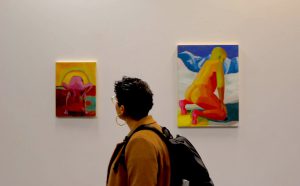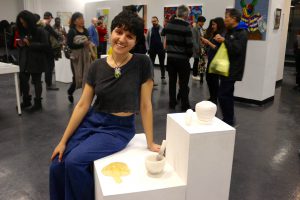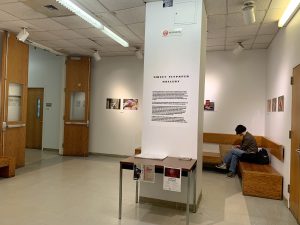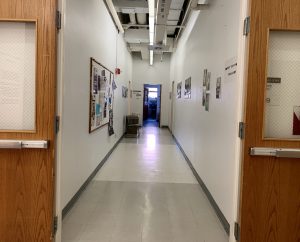A group of Hunter art students have developed an online petition demanding the former bookstore space on the ground floor of Hunter West be used for showing student work as a way to promote their studies. But officials say the space is valuable real estate that would better be used to generate funds for the college.
The Canvas, as the space is now called, is run by the Brooklyn-based artist collective Querencia Studios, whose lease expires this April. But while students were able to launch two shows at The Canvas, Querencia does not have a mission to work with Hunter students. The petition questions why the space should be leased to anyone who does not have Hunter students’ needs in mind.
“We want these choices to really reflect our best interests as students and to make sure that needs are being met before the space is outsourced in a way that we don’t have any say,” Hunter senior Briana Calderoń said. “We have a serious need here.”
Michael Alejandro Rowan started the petition along with five other students: Tara Ohanian, Isabelle Fernandez, Sabrina Persaud, Matthew Tibo and Theresa Vu. Prior to Canvas, the photography program at Hunter presented student work through a magazine, issuing one a semester for the past six years.
Students say there is a need for an easily accessible exhibition space, one that would showcase undergraduate craft year-round.
The college rents the 2,000-square-foot ground floor retail space to Querencia on a month-to-month lease. In light of their time left at Hunter, the property is currently listed “available” on the Colliers International website for a monthly rent of $46,390 for the street-level floor only. The rent is an additional $66,950 for the lower level, which has another 4,637 square feet.
Students in the undergraduate art department first curated a photography exhibit at Canvas this past January, titled the Alternative Photography Show. Art students and attendees both said they had a great turnout, attracting about 500 people.
“From a career perspective, this is the best development resource,” said Rowan, an art major whose work was in the show. “It’s amazing networking. There are many accomplishments happening at Hunter, and Hunter doesn’t seem particularly interested in it.”
After the success of the Alternative Photography Show, The Canvas gave students another opportunity to exhibit their work just two weeks later. Within those 14 days, 50 artists got involved and hundreds of people came to see the art on display.

“It’s kind of crazy that there’s such a demand for this. I’m proud to have participated. I hope there can be a lot more outlets like this,” Rowan said.
Students believe the fairest option would be to create a space for undergraduate work since the four art galleries Hunter owns strictly exhibit graduate work. They would like the space at 904 Lex to activate the whole Hunter community, not just the art department.
“There’s a lot of value in having these shows, both in having an engaged community at Hunter and also having the image of an engaged community at Hunter,” Rowan said.
While students may be frustrated, college officials say that 904 Lexington is valuable real estate that can generate money for the school that could be used for the students in other ways.
“It’s space that’s worth many thousands of dollars a month and the campus is very short of money,” said Bruce Payne, interim associate provost for the arts. “With the small amounts of extra money that we have from earned income, it goes toward student engagement.”
Payne said he sympathizes with the students and is in agreement that artists need to have their work seen by the public. “Art is communication,” he said. But he added that there are already options for undergraduate students to showcase their work, for example the 11th floor gallery in Hunter North, also known as Sweet Flypaper Gallery.

“It makes an enormous amount of sense for us to have lots of gallery space available for student work,” Payne said, adding that the gallery works very well for exhibits. “This place is well traveled and prominent.”
However, Payne said there could be more outreach to get other students to see their fellow students’ artwork.
“It’s a happy place for artists and their friends, but the rest of the campus isn’t regularly encouraged to go up there,” Payne said. “Both the student artists and the people running the department need to take that seriously.”
He believes bringing more attention to the art they already have at Sweet Flypaper Gallery and elsewhere could help the artists and the Hunter community as a whole.
“We’re a commuter college and we don’t have enough community, we don’t talk to each other enough. An art event can help promote that,” Payne said. “I think that the artists, of course, focus their attention on getting the stuff up and having it look good. But from the larger perspective, what we’re trying to do here is build a deeper and more thoughtful audience for the arts including for the visual arts and that means outreach, it means getting them in the door and it means getting them engaged in conversation.”
However, students say the Sweet Flypaper Gallery space is awkward and tight, and only allows a small number of people to gather. In fact, it is at the end of the hallway, and not in its own discrete space. People can pass through and the space does not have a lot of expanse of walls.

“It’s really just the hallway on the 11th floor,” said Calderoń. “It emerged as a result of us not having space to show our work, but not an actual solution.”
If a student gallery proceeds in the future, students aim to have two shows a semester.
“That is something a student never forgets, the first gallery space that opens a welcoming arm,”Calderoń said. “It is a huge way to form a better, deeper relationship between Hunter and the student body.”
The petition is still in circulation with more than 200 signatures so far and students hope to take their issue in front of officials, such as Payne, in the near future.
“We’ve been fighting uphill every stage and it doesn’t make sense because the output is incredible. We have incredible work and initiative,” Rowan said. “The only thing we don’t have is Hunter, which is the first thing you would think would be supporting this.”

